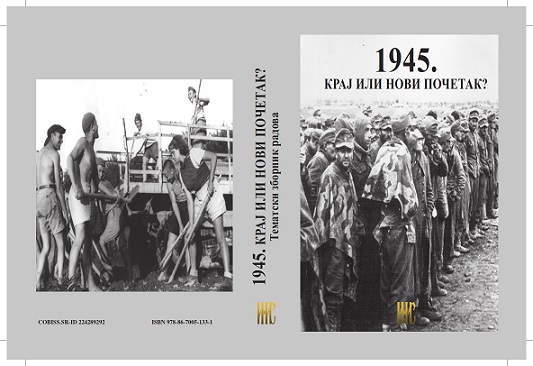Миграције нa територији Војводине 1945-1948. Узроци и демографске последице
Migrations in Vojvodina region 1945-1948. Causes and Demographic Consequences
Author(s): Željko Bjeljac, Aleksandra Terzić
Subject(s): Social history, Demography and human biology, WW II and following years (1940 - 1949), Migration Studies, Inter-Ethnic Relations
Published by: Institut za noviju istoriju Srbije
Keywords: migrations; colonization; 1945-1948; AP Vojvodina; demographic changes;
Summary/Abstract: The article is consisted of several chapters, discussing the process of migration flows in northern parts of the newly established state of Yugoslavia after the Second World War. It gives historical outlook to the happenings in Vojvodina region considering migration flows of different ethnicities in Vojvodina, as well as two great colonization flows in Vojvodina, before and after the Second World War. The study covers the causes of migration flows, geographical origin of settlers and distribution of settlements where colonization took its greatest effect as well as the consequences of the colonization process. Due to the demographic losses of the civilian population during the War, as well as high emigration of German and Hungarian population from Vojvodina, the demographic and spatial discharge of Vojvodina is evident. In 1945, the Agrarian Reform Law was created that included the colonization act. Although there are various estimates of the settlers' numbers, which are presented in this article, the general claim with an overall certainty is that all the republics of former Yugoslavia managed to achieve the colonization quota until 1947. The total number of colonized settlements in Vojvodina was 114. According to the previous research, it is estimated that the full extent of colonization was about 220,652 persons, based on the colonists list from 1948. Arrival of the population from different Yugoslav states, from 1946-1948, resulted with a large demographic changes in Vojvodina region, considering intense changes in population numbers, ethnic composition, different social, economic, ethnographic and political changes. According to data presented, Slavic, mostly Serbian population, due to the colonization process, after Second World War consisted the half of total Vojvodina population. Certain regularities in settling process in Vojvodina during the colonization period were noted. In colonization of Srem County, the predominance of federal migrants from BiH and Croatia is evident, while in Bačka significant participation of settlers from BiH, Croatia and Montenegro is noted, with significantly lower rates of immigrants from Central Serbia. When it comes to the Banat County, a significant dominance of immigrants from Bosnia and Central Serbia is evident, with lower rates of immigrants from other republics. There was the dominance of certain ethnic groups in some areas and specific settlements, as settlers from close regions tend to be concentrated in one village. This colonization also had some benefits for rapid adaptation of settlers, because the grouping was set on a regional basis, and that later migrations followed the same pattern.
Book: 1945. Kpaj или нови почетак?
- Page Range: 375-400
- Page Count: 26
- Publication Year: 2016
- Language: Serbian
- Content File-PDF

